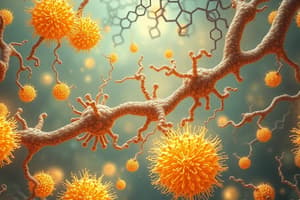Podcast
Questions and Answers
What is the ultimate function of metabolism within a microbe?
What is the ultimate function of metabolism within a microbe?
- To store energy in ATP
- To acquire nutrients
- To reproduce the organism (correct)
- To synthesize large molecules
Which statement accurately describes anabolic pathways?
Which statement accurately describes anabolic pathways?
- They synthesize large molecules from catabolic products.
- They require energy for the synthesis of molecules. (correct)
- They release more energy than they require.
- They break down larger molecules into smaller products.
What role do electron carriers play in metabolic reactions?
What role do electron carriers play in metabolic reactions?
- Transport nutrients to cells
- Facilitate the breakdown of large molecules
- Transfer electrons from an electron donor to an electron acceptor (correct)
- Initiate the reproduction of cells
Which molecule stores energy that is essential for metabolic processes?
Which molecule stores energy that is essential for metabolic processes?
In which type of reaction do cells break down larger molecules into smaller products?
In which type of reaction do cells break down larger molecules into smaller products?
What is the primary function of enzymes in metabolic reactions?
What is the primary function of enzymes in metabolic reactions?
Flashcards
Microbial metabolism's ultimate function?
Microbial metabolism's ultimate function?
To reproduce the organism.
Anabolic pathways
Anabolic pathways
Anabolic pathways require energy for the synthesis of molecules.
Electron carriers
Electron carriers
Transfer electrons from an electron donor to an electron acceptor.
Energy storage molecule?
Energy storage molecule?
Signup and view all the flashcards
Breaking down molecules
Breaking down molecules
Signup and view all the flashcards
Enzymes function
Enzymes function
Signup and view all the flashcards
Study Notes
Metabolism Overview
- Metabolism is a collection of controlled biochemical reactions within a microbe that ultimately aims to reproduce the organism
Basic Chemical Reactions
- Eight statements guide metabolic processes:
- Every cell acquires nutrients
- Metabolism requires energy from light or catabolism of nutrients
- Energy is stored in adenosine triphosphate (ATP)
- Cells catabolize nutrients to form precursor metabolites
- Precursor metabolites, energy from ATP, and enzymes are used in anabolic reactions
- Enzymes plus ATP form macromolecules
- Cells grow by assembling macromolecules
- Cells reproduce once they have doubled in size
Types of Metabolic Reactions
- Two major classes of metabolic reactions:
- Catabolic pathways:
- Break larger molecules into smaller products
- Exergonic (release energy)
- Anabolic pathways:
- Synthesize large molecules from the smaller products of catabolism
- Endergonic (require more energy than they release)
- Catabolic pathways:
Oxidation and Reduction Reactions
- Involve the transfer of electrons from an electron donor to an electron acceptor
- Reactions always occur simultaneously
- Cells use electron carriers to carry electrons (often in H atoms)
- Three important electron carriers:
- Nicotinamide adenine dinucleotide (NAD+)
- Nicotinamide adenine dinucleotide phosphate (NADP+)
- Flavin adenine dinucleotide (FAD)
Studying That Suits You
Use AI to generate personalized quizzes and flashcards to suit your learning preferences.



